Abstract
The meeting discussed two main areas concerning maternal anthropometry in developing countries: (1) how various anthropometric indicators can be best utilized for assessing and monitoring the nutritional status of women at different times in their reproductive lives, and (2) the predictive value of various anthropometric indicators for identifying benefit or risk for maternal and perinatal/neonatal health and nutritional outcomes of pregnancy. The indicators discussed were prepregnancy weight, height, weight gain in pregnancy, arm circumference, weight-for-height and body mass index (weight (kg)/height (m)2). Some 50 experts reached consensus on the tools for assessing maternal nutritional status for widespread field application in developing countries, and on priority research needs. This Memorandum summarizes the general recommendations which have important and immediate field applications, as well as priority research issues related to specific indicators.
Full text
PDF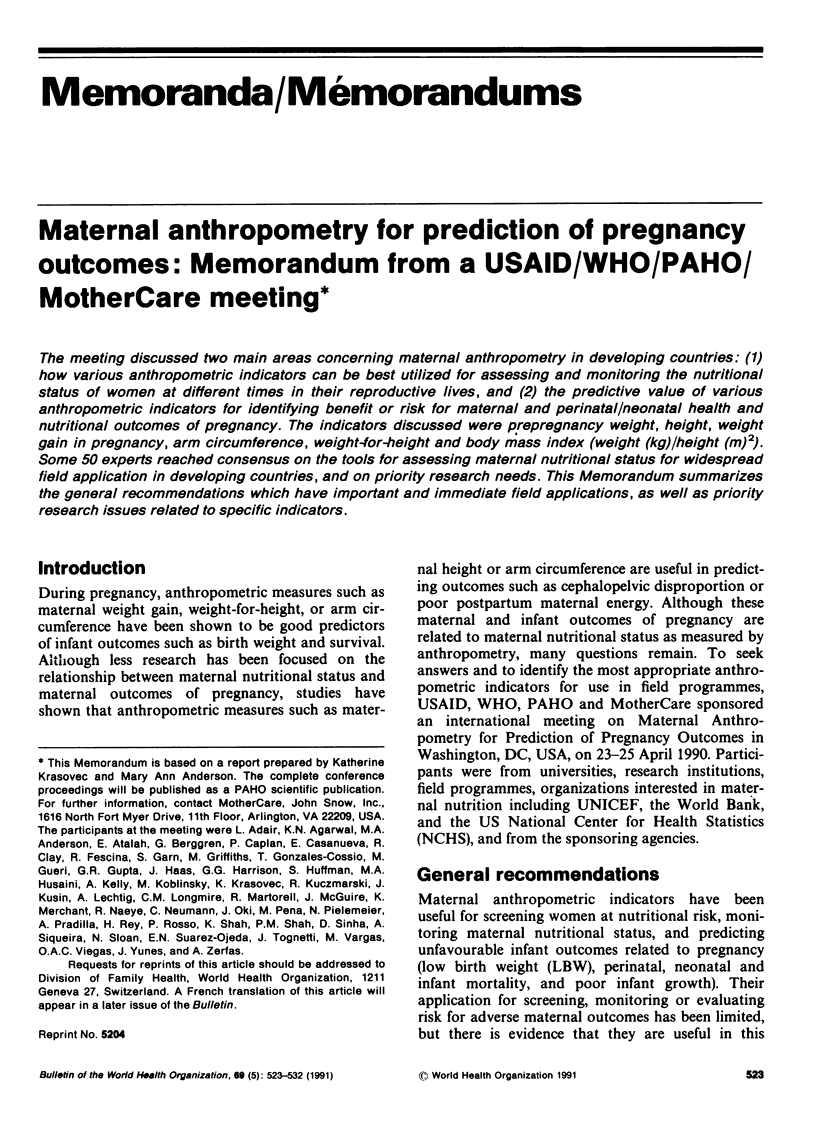
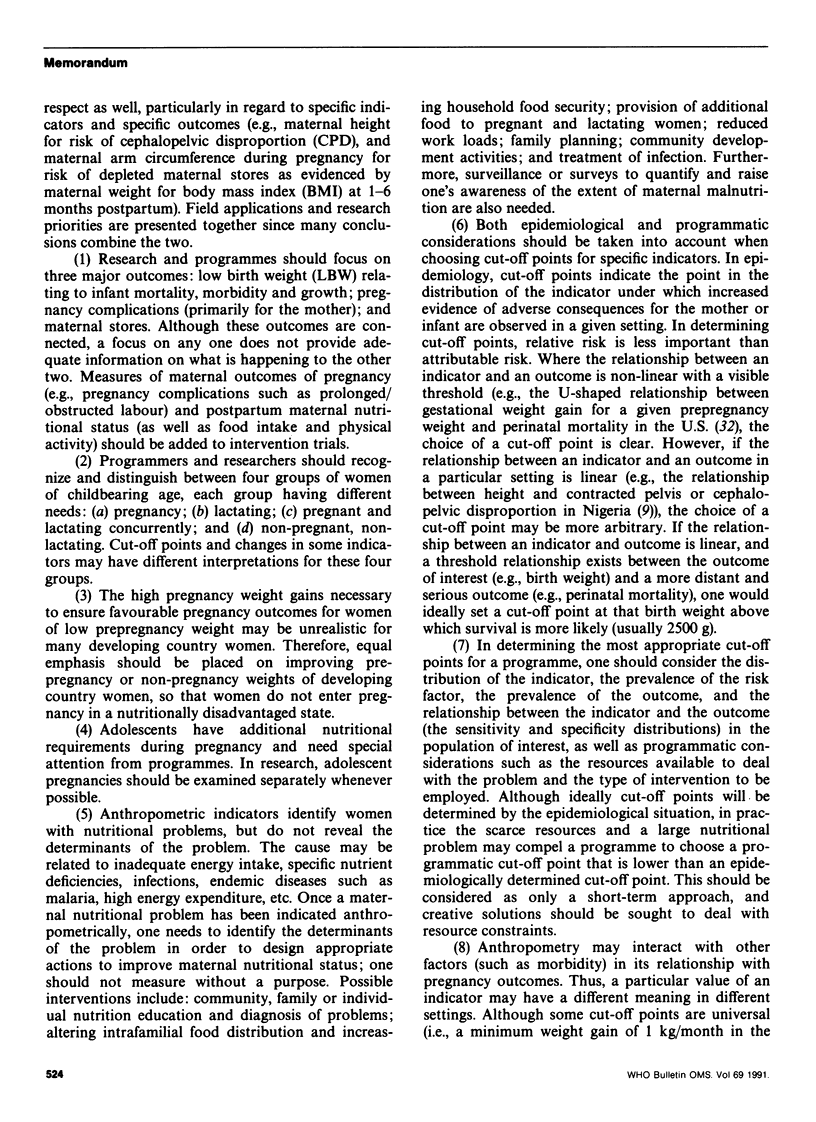
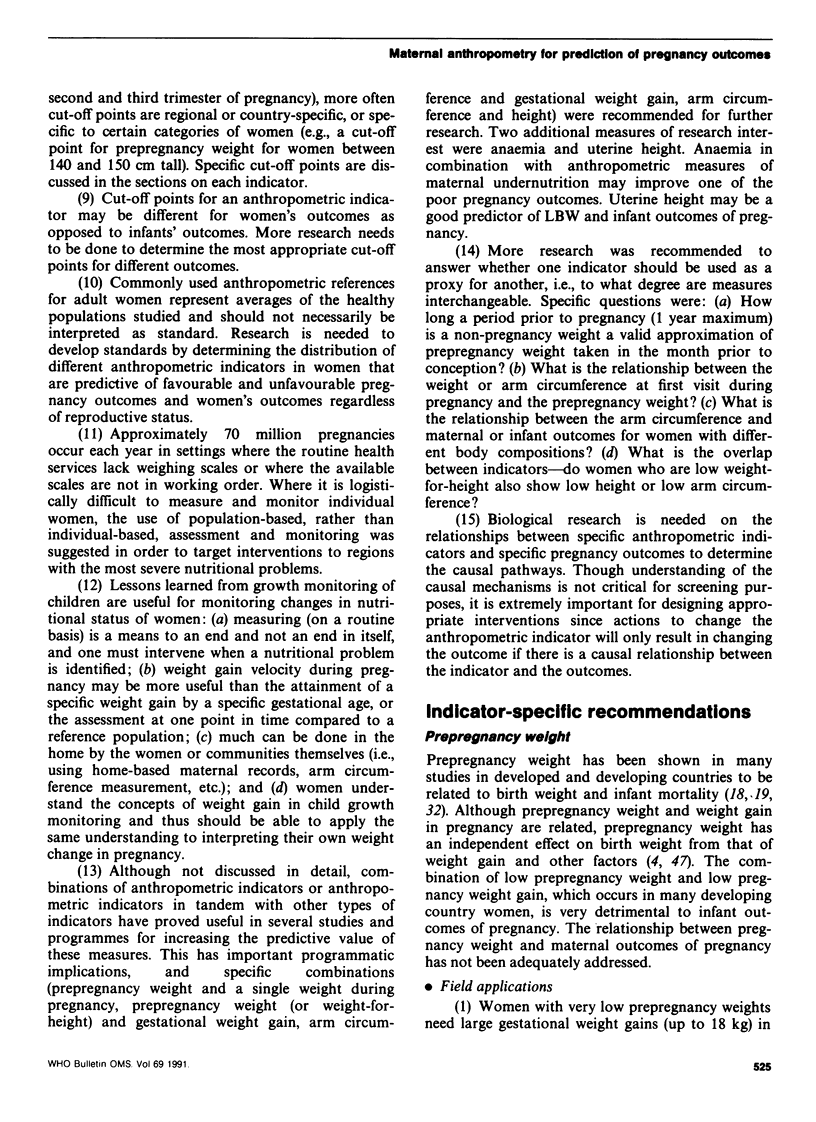

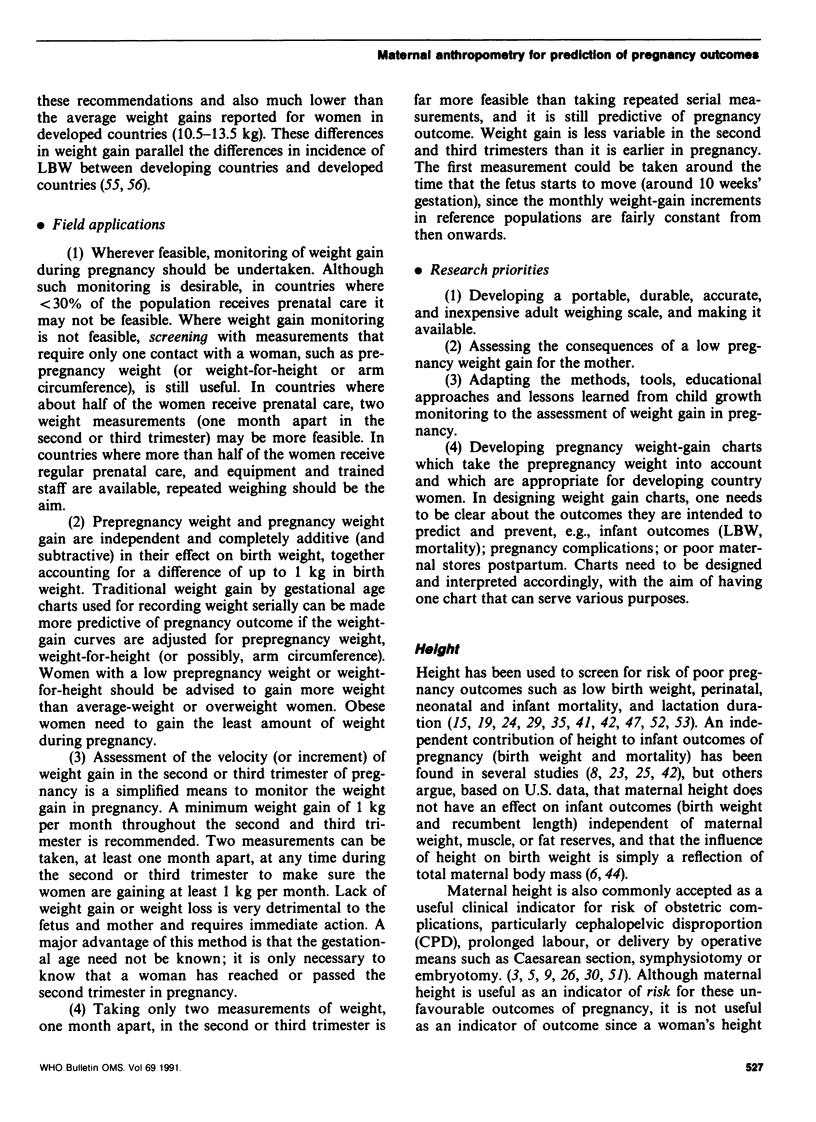


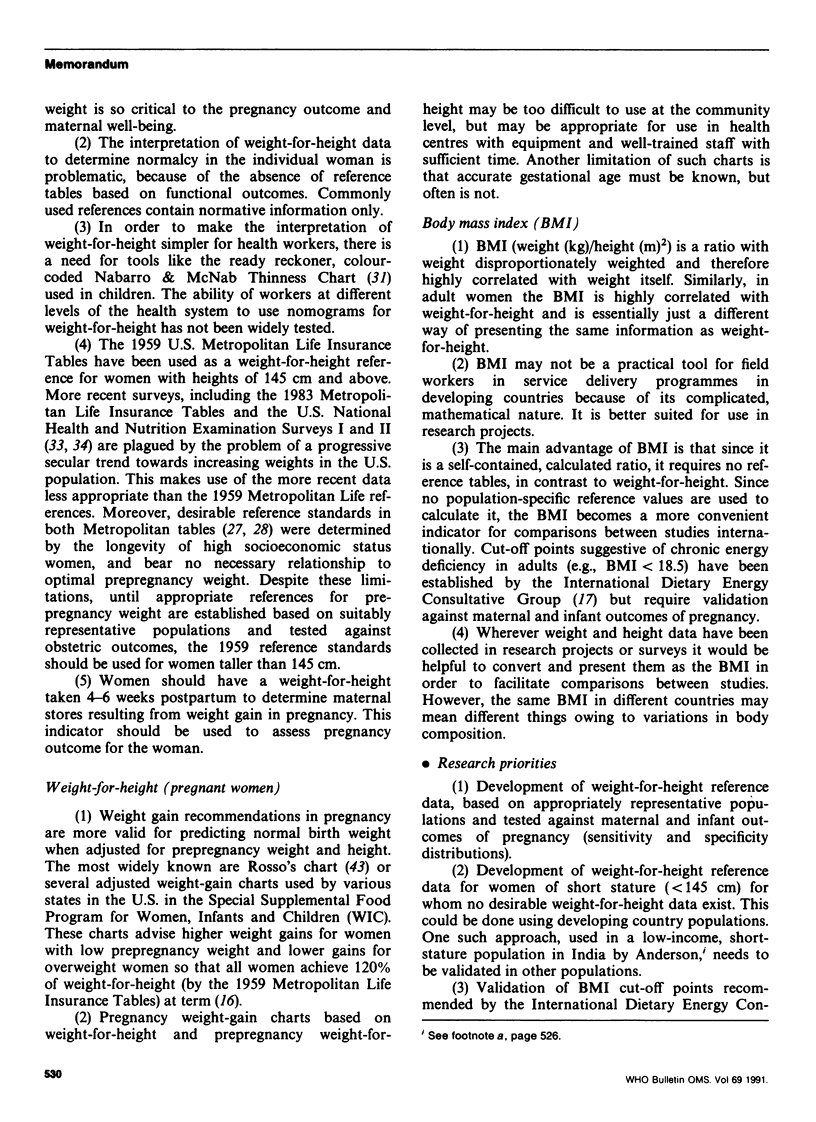


Selected References
These references are in PubMed. This may not be the complete list of references from this article.
- Adair L. S., Pollitt E., Mueller W. H. Maternal anthropometric changes during pregnancy and lactation in a rural Taiwanese population. Hum Biol. 1983 Dec;55(4):771–787. [PubMed] [Google Scholar]
- Eastman N. J., Jackson E. Weight relationships in pregnancy. I. The bearing of maternal weight gain and pre-pregnancy weight on birth weight in full term pregnancies. Obstet Gynecol Surv. 1968 Nov;23(11):1003–1025. [PubMed] [Google Scholar]
- Garn S. M., Pesick S. D. Relationship between various maternal body mass measures and size of the newborn. Am J Clin Nutr. 1982 Oct;36(4):664–668. doi: 10.1093/ajcn/36.4.664. [DOI] [PubMed] [Google Scholar]
- Huffman S. L., Wolff M., Lowell S. Nutrition and fertility in Bangladesh: nutritional status of nonpregnant women. Am J Clin Nutr. 1985 Oct;42(4):725–738. doi: 10.1093/ajcn/42.4.725. [DOI] [PubMed] [Google Scholar]
- Hull V. J. The Ngaglik study: an inquiry into birth interval dynamics and maternal and child health in rural Java. World Health Stat Q. 1983;36(2):100–118. [PubMed] [Google Scholar]
- James W. P., Ferro-Luzzi A., Waterlow J. C. Definition of chronic energy deficiency in adults. Report of a working party of the International Dietary Energy Consultative Group. Eur J Clin Nutr. 1988 Dec;42(12):969–981. [PubMed] [Google Scholar]
- Kramer M. S. Determinants of low birth weight: methodological assessment and meta-analysis. Bull World Health Organ. 1987;65(5):663–737. [PMC free article] [PubMed] [Google Scholar]
- Lechtig A., Delgado H., Yarbrough C., Habicht J. P., Martorell R., Klein R. E. A simple assessment of the risk of low birth weight to select women for nutritional intervention. Am J Obstet Gynecol. 1976 May 1;125(1):25–34. doi: 10.1016/0002-9378(76)90886-3. [DOI] [PubMed] [Google Scholar]
- MILLER R. A. Factors influencing lactation. Part I. Maternal. Arch Dis Child. 1952 Apr;27(132):187–194. doi: 10.1136/adc.27.132.187. [DOI] [PMC free article] [PubMed] [Google Scholar]
- Martorell R., Delgado H. L., Valverde V., Klein R. E. Maternal stature, fertility and infant mortality. Hum Biol. 1981 Sep;53(3):303–312. [PubMed] [Google Scholar]
- Moerman M. L. Growth of the birth canal in adolescent girls. Am J Obstet Gynecol. 1982 Jul 1;143(5):528–532. doi: 10.1016/0002-9378(82)90542-7. [DOI] [PubMed] [Google Scholar]
- Nabarro D., McNab S. A simple new technique for identifying thin children: a description of a wallchart which enables minimally trained health workers to identify children who are so thin, or wasted, that they require immediate nutritional help. J Trop Med Hyg. 1980 Feb;83(1):21–33. [PubMed] [Google Scholar]
- Olukoya A. A. Identification of underweight women by measurement of the arm circumference. Int J Gynaecol Obstet. 1990 Mar;31(3):231–235. doi: 10.1016/0020-7292(90)91016-j. [DOI] [PubMed] [Google Scholar]
- Prentice A. M., Cole T. J., Foord F. A., Lamb W. H., Whitehead R. G. Increased birthweight after prenatal dietary supplementation of rural African women. Am J Clin Nutr. 1987 Dec;46(6):912–925. doi: 10.1093/ajcn/46.6.912. [DOI] [PubMed] [Google Scholar]
- Rosso P. A new chart to monitor weight gain during pregnancy. Am J Clin Nutr. 1985 Mar;41(3):644–652. doi: 10.1093/ajcn/41.3.644. [DOI] [PubMed] [Google Scholar]
- Shah K. P., Shah P. M. Relationship of weight during pregnancy and low birth weight. Indian Pediatr. 1972 Sep;9(9):526–531. [PubMed] [Google Scholar]
- Shah K. P., Shah P. M. The mother's card: a simplified aid for primary health workers. WHO Chron. 1981 Feb;35(2):51–53. [PubMed] [Google Scholar]
- Thomson A. M., Billewicz W. Z., Hytten F. E. The assessment of fetal growth. J Obstet Gynaecol Br Commonw. 1968 Sep;75(9):903–916. doi: 10.1111/j.1471-0528.1968.tb01615.x. [DOI] [PubMed] [Google Scholar]
- Winikoff B., Debrovner C. H. Anthropometric determinants of birth weight. Obstet Gynecol. 1981 Dec;58(6):678–684. [PubMed] [Google Scholar]


